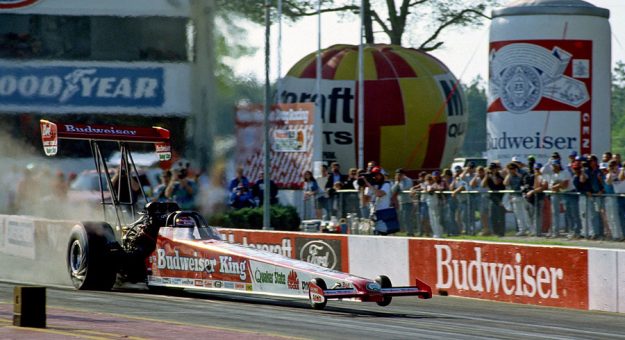HARRISBURG, N.C. — When race fans across the country retrieved the March 25, 1992, issue of National Speed Sport News from their mailboxes, they saw this among the front-page headlines — “Bernstein Tops 300!”
Amazingly, it’s been 30 years since Kenny Bernstein broke what many believed to be drag racing’s last major performance barrier.
Bernstein achieved the milestone on March 20, 1992, when he ran 301.70 mph during Top Fuel qualifying for the 23rd annual NHRA Gatornationals at Florida’s Gainesville Raceway.
Bernstein credited his team — headed by crew chief Dale Armstrong and assistant Wes Cerny — the track and the weather conditions for making him the first to run faster than 300 mph in a piston-driven dragster.
“I’ve been saying from day one that to do this there would have to be perfect conditions and everything on the car would have to be just right, and it was,” said the driver of the Budweiser King dragster. “At the end of the run, the engine started to go just a taste sour. Normally, I would have lifted my foot off the throttle, but I told myself I had to drive all the way out the back door because this might be the run. And I didn’t care whether I dropped cylinders or not.”
After his 300-mph pass, Bernstein posted speeds of 298.29, 298.30 and 299.30 to successfully back up his record within the one percent required by NHRA rules.
Bernstein’s history-making run was not unexpected after he hired Cerny during the offseason to work alongside Armstrong.
Cerny is the man given the bulk of the credit for Jim White’s 291.82 mph Funny Car speed record at the end of the 1991 season while Armstrong, Bernstein’s longtime crew chief, made his driver the first to break the 260- and 270-mph barriers in a Funny Car.
While Bernstein gained one record at the Gatornationals, he lost another as ageless Eddie Hill lowered the Top Fuel elapsed time mark to 4.801 seconds with a supporting run of 4.841.
Hill also beat Bernstein in the final round of eliminations, making the 56-year-old veteran the oldest professional winner in NHRA history. The final-round decision came quickly as Bernstein smoked the tires at the starting line while Hill streaked across the finish line in 4.486 seconds at 290.51 mph.
“I was disappointed to lose the race, but I’m still proud of the milestone we achieved this weekend,” Bernstein was quoted in NSSN.
A measure of the record crowd for the Sunday portion of the 1992 Gatornationals was the doublewide line of traffic that was still being directed into parking lots two hours after the start of eliminations.
Even though the length of the track has been reduced from 1,320 feet to 1,000 feet, speeds have continued to climb in NHRA competition. Today, Brittany Force holds the Top Fuel speed record at 338.17 mph.
Keeping our nose in the archives, it’s been 20 years since a safety innovation that would forever change superspeedway racing debuted on May 5, 2002.
That’s the day practice for the 86th Indianapolis 500 started at Indianapolis Motor Speedway and 4,240 feet of the track’s concrete retaining wall was covered with the new Steel and Foam Energy Reduction barrier.
Under development by the Indy Racing League and the University of Nebraska-Lincoln’s Midwest Roadside Safety Facility since 1998, the SAFER barrier was designed to absorb multiple impacts by Indy cars and stock cars during the course of an event. NASCAR joined in the development of the project in June 2000.
The SAFER barrier received its first real-world test the same day it debuted when Robby McGehee lost control and crashed backward into the turn-three wall.
“That was an enormous impact by Robby. He was running at 218 and 219 mph,” said Brian Barnhart, the IRL’s vice president of operations. “We are analyzing the data, but the first analysis of the wall is we are very encouraged by what we saw out there.”
McGehee never lost consciousness but did suffer several small fractures in his upper spine and lower left leg.
